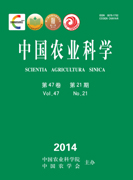-
Establishment and Application of Large-Scale Transformation Systems in Wheat
- YE Xing-guo, XU Hui-jun, DU Li-pu, HE Guang-yuan, WANG Ke, LIN Zhi-shan
-
Scientia Agricultura Sinica. 2014, 47(21):
4155-4171.
doi:10.3864/j.issn.0578-1752.2014.21.003
-
 Abstract
(
842 )
Abstract
(
842 )
 HTML
(
7 )
HTML
(
7 )
 PDF (1087KB)
(
1411
)
PDF (1087KB)
(
1411
)
 Save
Save
-
References |
Related Articles |
Metrics
Wheat is a plant that is relatively difficult to be genetically modified through traditional transgenic approaches among several major field crops. Factors restricting the transformation of wheat include small scale and low efficiency of transformation, poor repeatability, and fewer availability of transgenic materials with satisfied appearances, and thus leading to the lagged-behind of wheat in transgenic breeding compared to soybean, maize, cotton, and rice. Presently, transgenic techniques mainly used in wheat transformation are biolistic particle and Agrobacterium-mediated transformation based on in vitro tissue culture, although methods of pollen tube pathway, ion beam implantation, laser microbeam puncture, polyethylene glycol (PEG) medium, pollen-mediated, and Agrobacterium dipping floral have also been employed in some laboratories. In the aspect of recipient tissues, wheat immature embryo and its derived callus were mostly used as initiating materials for the transformation of target genes, but transgenic wheat plants were also reported to be obtained by using mature embryo, inflorescence, and anther derived callus, which still need to be investigated and confirmed. As for the transformation efficiency reported in wheat, 0.1%-16.7% is for particle bombardment and 0.7%-44.8% for Agrobacterium. A big variation still existed. In the matter of alien transferring genes for wheat, the target genes are mainly involved in wheat enhancement of flour quality, disease resistance, drought tolerance, aphids resistance, and herbicide tolerance except some selection or reporter genes such as nptⅡ, bar, hpt, GUS, GOX, pmi, and ALS. The transformation efficiency of wheat immature embryos mediated by Agrobacterium and particle gun is dramatically affected not only by genotypes, but also by the physiological status of mother plants which is determined by temperature, light, nutrition, and water supply during the growth period. Especially, the suitable day/night temperature during the period between anthesis and sampling of the donor plants is mostly beneficial to the embryonic callus induction and putative transgenic regeneration after transformation. Generally, the development of wheat transgenic technology in China has been largely progressed, for examples, the establishment of high regeneration system of wheat mature embryos and its successful application, optimization of regeneration and transformation system of wheat immature embryos, introduction of a group of interested genes related to wheat improvement in disease control, drought resistance and quality enhancement, preliminary setting up of wheat transformation system with larger scale, etc. However, there is still a big gap between the current status in China and the top-level international biotechnology companies regarding to the efficiency or scale in wheat transformation. It is thought that low transformation rate, strong genotype-dependence, and imperfect artificial climate conditions, as well as unstable manipulating team are the bottleneck to limit the application of wheat transformation technology by large scale in China. Future studies in this field should include the use of commercial wheat varieties, improvement of transformation efficiency, development of marker-free wheat plants, introduction of multiple target genes, integration of foreign genes at specific sites, avoidance of backbone insertion and transgene silencing, etc. Wheat transformation efficiency and scale will be improved and expanded by further modifications of plant regeneration system, exploration of regeneration and transformation-associated genes. Other aspects involve the screening of ideal genotypes, medium and technique improvement of co-culture, optimization and combination of various factors in transformation process. Development and application of biolistic particle and Agrobacterium mediated wheat transformation was reviewed in this article. Particularly, the progress of wheat transgenic technology for large scale performance in the latest five years was studied, which may provide useful information for the transformation of candidate genes for functional analysis and the breeding of transgenic wheat varieties.









